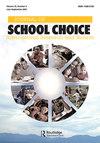School Choice (And Diversity) in the UK since 1944: Continuity, Change, Divergence and School Selectivity
Q2 Social Sciences
引用次数: 1
Abstract
ABSTRACT This paper focuses on school choice and diversity in the UK (England, Wales, Scotland and Northern Ireland) in historical context. Drawing on primary and secondary documentary sources it assesses continuity, change and divergence, before addressing existing diversity and school choice, and academic outcomes. The 1944 Education Act and associated legislation established, in each country, a system of state-funded church and state schools, comprising, academically selective (grammar) and non-selective secondary schools, with test scores determining whether the child was allocated to a selective or non-selective school. The paper argues that there has been broad continuity in Northern Ireland, whilst from 1965 England, Wales and Scotland diverged when school systems were reorganized – to a greater or lesser extent – along comprehensive lines. From the 1980s, parental “choice” (and diversity) policies were implemented in all countries, albeit differently. It is argued that existing school diversity across the UK is associated with distinctive histories and political ideas, and with varying levels and types of school selectivity and social segregation. Furthermore, the institutional rules regarding who is prioritized for a school place in the event of oversubscription – particularly in the case of selective and religious schools – can constrain parental choice as they enable schools to “select in” and “select out” certain students. Whilst improving educational standards was a key goal for the Conservative government when it introduced market-oriented reforms in England, evidence points to improved academic outcomes being related to changes in assessment policy.1944年以来英国的学校选择(和多样性):连续性、变化性、差异性和学校选择性
摘要本文关注历史背景下英国(英格兰、威尔士、苏格兰和北爱尔兰)的学校选择和多样性。它利用小学和中学的文献来源,在处理现有的多样性、学校选择和学术成果之前,评估了连续性、变化和差异。1944年的《教育法》和相关立法在每个国家建立了一个由国家资助的教会和州立学校体系,包括学术选择性(语法)和非选择性中学,考试成绩决定孩子是被分配到选择性学校还是非选择性学校。该论文认为,北爱尔兰有着广泛的连续性,而从1965年起,英格兰、威尔士和苏格兰在学校系统重组时出现了分歧——或多或少——沿着全面的路线。从20世纪80年代开始,所有国家都实施了父母的“选择”(和多样性)政策,尽管有所不同。有人认为,英国现有的学校多样性与独特的历史和政治思想有关,也与不同程度和类型的学校选择性和社会隔离有关。此外,在超额认购的情况下,关于谁优先获得入学名额的制度规则——特别是在选择性和宗教学校的情况下——可能会限制家长的选择,因为它们使学校能够“挑选”和“挑选”某些学生。虽然提高教育水平是保守党政府在英格兰推行市场化改革时的一个关键目标,但有证据表明,学术成果的改善与评估政策的变化有关。
本文章由计算机程序翻译,如有差异,请以英文原文为准。
求助全文
约1分钟内获得全文
求助全文

 求助内容:
求助内容: 应助结果提醒方式:
应助结果提醒方式:


